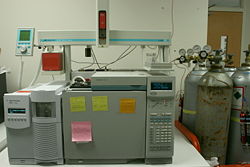SPME
From LEAP
| Line 22: | Line 22: | ||
Solid phase microextraction is a fast, solvent less alternative to conventional sample extraction techniques. In SPME, analytes establish equilibria among the sample matrix, the headspace above the sample, and a polymer-coated fused fiber, then are desorbed from the fiber to a chromatography column. Because analytes are concentrated on the fiber, and are rapidly delivered to the column, minimum detection limits are improved and resolution is maintained. | Solid phase microextraction is a fast, solvent less alternative to conventional sample extraction techniques. In SPME, analytes establish equilibria among the sample matrix, the headspace above the sample, and a polymer-coated fused fiber, then are desorbed from the fiber to a chromatography column. Because analytes are concentrated on the fiber, and are rapidly delivered to the column, minimum detection limits are improved and resolution is maintained. | ||
SPME is compatible with analyte separation/detection by gas chromatography or HPLC, and provides linear results for wide concentrations of analytes. | SPME is compatible with analyte separation/detection by gas chromatography or HPLC, and provides linear results for wide concentrations of analytes. | ||
| - | |||
| - | |||
| - | |||
Revision as of 22:48, 4 May 2009

| GC SPME |
| Application Type | |
| STANDARD | |
| Application ID | |
| GCSPME | |
| Description | |
| GC SPME |
Contents |
Abstract
Solid phase microextraction, or SPME, is a sample preparation technique used both in the laboratory and on-site. Developed in the early 1990s at the University of Waterloo by Dr. Pawliszyn's group, it is a simple and inexpensive technique where the use of solvents is not necessary.
SPME can be thought of as a very short gas chromatography column turned inside out. SPME involves the use of a fiber coated with an extracting phase, that can be a liquid (polymer) or a solid (sorbent), which extracts different kinds of analytes (including both volatile and non-volatile) from different kinds of media, that can be in liquid or gas phase. The quantity of analyte extracted by the fiber is proportional to its concentration in the sample so long as equilibrium is reached or, in case of short time pre-equilibrium, with help of convection or agitation. After extraction, the SPME fiber is transferred to the injection port of separating instruments, such as a Gas Chromatograph, where desorption of the analyte takes place and analysis is carried out.
The attraction of SPME is that the extraction is fast and simple and can be done without solvents, and detection limits can reach parts per trillion (ppt) levels for certain compounds. SPME also has great potential for field applications; on-site sampling can be done even by nonscientists without the need to have a GC-MS at each location. When properly stored, samples can be analyzed days later in the laboratory without significant loss of volatiles.
Solid phase microextraction is a fast, solvent less alternative to conventional sample extraction techniques. In SPME, analytes establish equilibria among the sample matrix, the headspace above the sample, and a polymer-coated fused fiber, then are desorbed from the fiber to a chromatography column. Because analytes are concentrated on the fiber, and are rapidly delivered to the column, minimum detection limits are improved and resolution is maintained. SPME is compatible with analyte separation/detection by gas chromatography or HPLC, and provides linear results for wide concentrations of analytes.
Photos
SPME offers some important advantages:
- Single Step Extraction - reduces sample preparation time by 70%
- Versatility - various selectivities available, adapts to any GC or HPLC system, can be automated
- Efficient & Economical - little/no use of solvents, quantitative method, allows more than 50 extractions per fiber on average
Useful links
Contact LEAP
For additional information about this technique please contact LEAP Technologies for detailed information








